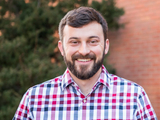Dr. Justin Webster receives a new NSF grant
Project Title: Experiment, Theory, and Simulation of Aeroelastic Limit Cycle Oscillations for Energy Harvesting Applications
Dr. Justin Webster has been awarded an NSF grant (DMS–1907620) in the amount of $232,995 for the period 2019–2022 by the Division of Mathematical Sciences, Applied Mathematics Program. This is part of a collaborative proposal with Duke University (Earl Dowell, Mechanical and Civil Engineering) and Carnegie Mellon University (Jason Howell, Computational Mathematics). UMBC is the lead institution on the multi-institution grant, which totals $738,000.
Abstract:
Given the emphasis on carbon-free energy, power system minimization, and decentralized power generation, the development of vibration-based energy harvesting technologies has become a topic of great interest over the past 20 years. A typical aeroelastic energy harvesting scheme involves immersing a thin, elastic structure in a fluid flow. Under certain conditions, the presence of the flow brings about a structural self-excited vibration, known as flutter, resulting in periodic oscillations. Via affixed piezo-electric materials, electrical energy can be harvested from these structural oscillations, and this sort of energy holds promise as an alternative energy source. To effectively and efficiently harvest energy from this system, one must understand the qualitative features of the resulting limit cycle oscillation.
This project derives and analyzes PDE models for the post-flutter behavior of cantilevered structures in an axial flow of fluid. Specifically, it:
- improves cantilever modeling and makes predictions that will lead to better energy harvesting devices;
- develops a rigorous theory of PDE solutions for a novel elasticity model;
- addresses a gap in the mathematical literature concerning unstable nonlinear cantilevers;
- refines spectral and finite element computational methods for nonlinear cantilevers;
- creates a synergy of modeling, theory, computation, and wind-tunnel experimentation;
- provides a clearly formulated, challenging mathematical problem with a direct and realizable connection to engineering applications.
Posted: August 17, 2019, 9:08 AM
